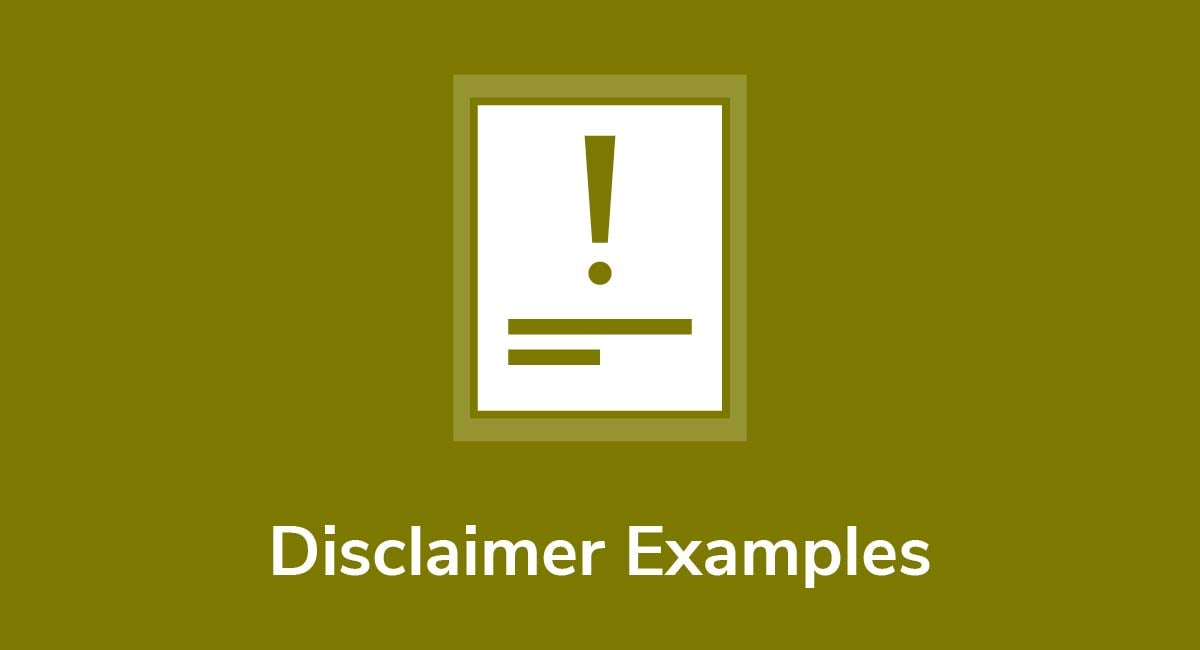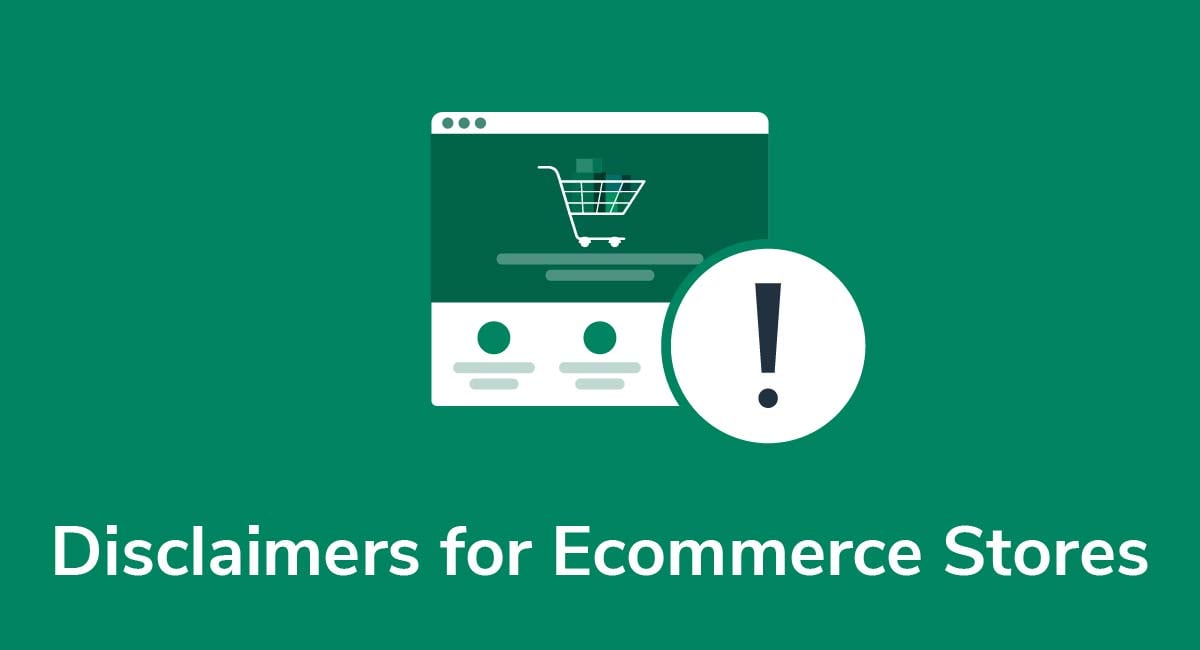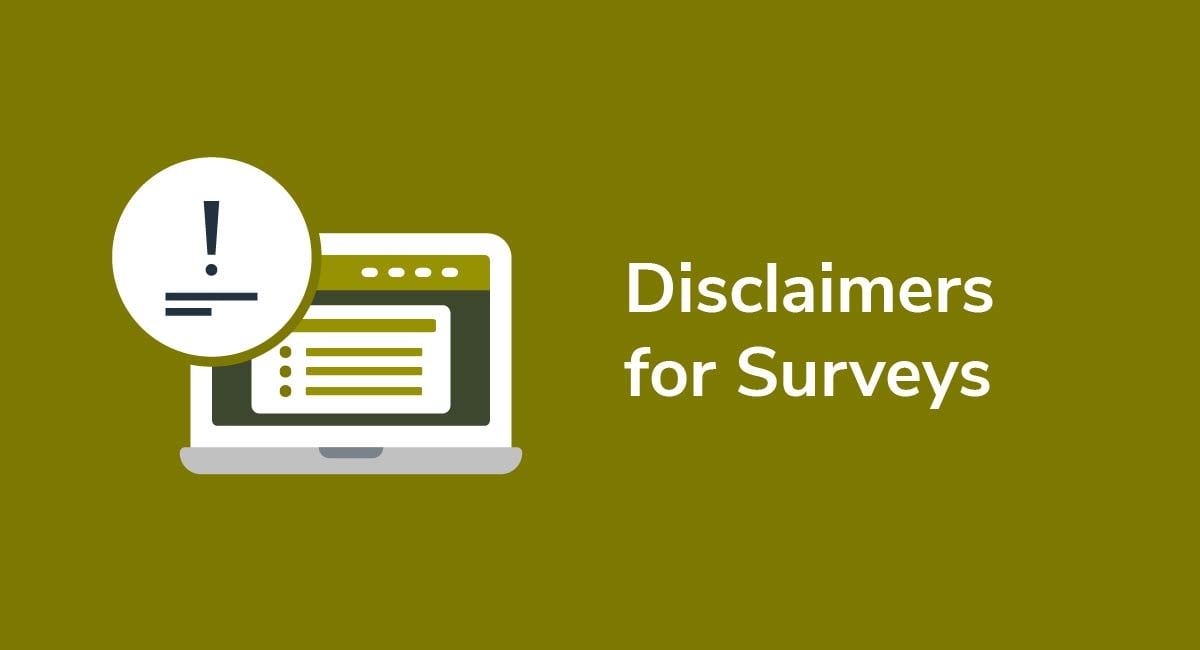Fair Use Disclaimers
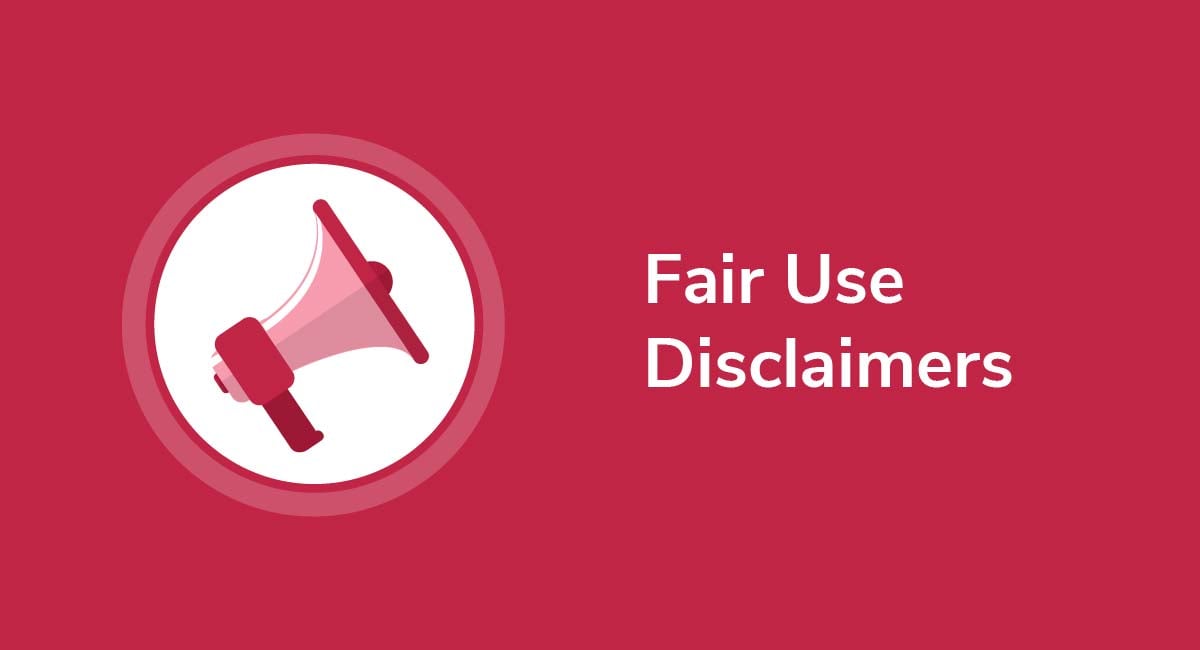
In the United States, you can use copyrighted works without permission so long as the use falls within the definition of "fair use." If you plan on using copyrighted material in this way on your website, you need to display a fair use disclaimer.
In this article, we'll look at what constitutes fair use under U.S. law and how to draft your own fair use disclaimer.
Get compliant today with PrivacyPolicies.com
Select one of our generators to create the required legal agreements for your business:
- Our Privacy Policy Generator can help you generate a customized Privacy Policy in around three minutes, for free.
- Our Terms & Conditions Generator can help you generate a customized Terms & Conditions agreement in around three minutes, for free.
- Our EULA Generator can create a customized End-User License Agreement for your mobile or desktop app.
- Our Cookies Policy Generator can create a customized Cookies Policy to help your compliance with ePrivacy Directive and GDPR.
- Our Disclaimer Generator can create a disclaimer or disclosure for your website.
- Our Return & Refund Policy Generator can help your ecommerce store by creating a returns or refunds policy.
Integrate a free Cookies Notice and Cookie Consent banner to comply with the EU ePrivacy Directive and the new GDPR law regarding cookies.
- 1. What is Copyright?
- 2. What Constitutes "Fair Use" Under U.S. Law?
- 2.1. 1. Purpose and Character of Use
- 2.2. 2. Nature of Copyrighted Work
- 2.3. 3. Amount of Copyrighted Work Used
- 2.4. 4. Effect on Market Value of the Copyrighted Work
- 3. What are Fair Use Disclaimers?
- 4. How Long Does Copyright Protection Last in the U.S.?
- 5. Benefits of Having a Fair Use Disclaimer
- 5.1. 1. Encourages Fair Information Sharing
- 5.2. 2. Boosts Your Reputation for Following Copyright Law
- 5.3. 3. Minimizes the Risk of Lawsuits
- 6. Who Needs a Fair Use Disclaimer?
- 7. Drafting a Fair Use Disclaimer
- 7.1. Declaration of Use
- 7.2. Explain the Purposes for the Use
- 7.3. An Explanation of Fair Use
- 7.4. Cite U.S. Copyright Law
- 7.5. Third Party Use
- 8. Displaying a Fair Use Disclaimer
- 8.1. Website Footer
- 8.2. With the Copyrighted Content
- 9. Conclusion
What is Copyright?
When someone produces a piece of creative work, it's protected by copyright from the moment of creation. Examples of such works that get copyright protection upon creation include but aren't limited to the following:
- Blogs
- Computer programs
- Novels
- Paintings
- Plays
- Poems
- Songs
Under U.S. law, you can't normally use, copy, distribute, perform, or display copyrighted work without the owner's express permission. The rules are set out in Title 17 of the United States Code, which includes the Copyright Act of 1976 and related laws.
There's an exception to this general rule, though, known as the fair use doctrine. Under this doctrine, you can use copyrighted material if:
- You use it in a transformative way, and
- You don't take credit for the original copyrighted work
What Constitutes "Fair Use" Under U.S. Law?

The Copyright Act of 1976 establishes that it's fair to use copyrighted works for certain purposes such as reporting, teaching, commenting, or researching. To determine whether the usage is "fair," consider four factors in Title 17 Section 107: The reason for use, the nature of the copyrighted work, how much copyrighted content is used, and whether the use changes the value of the copyrighted work:
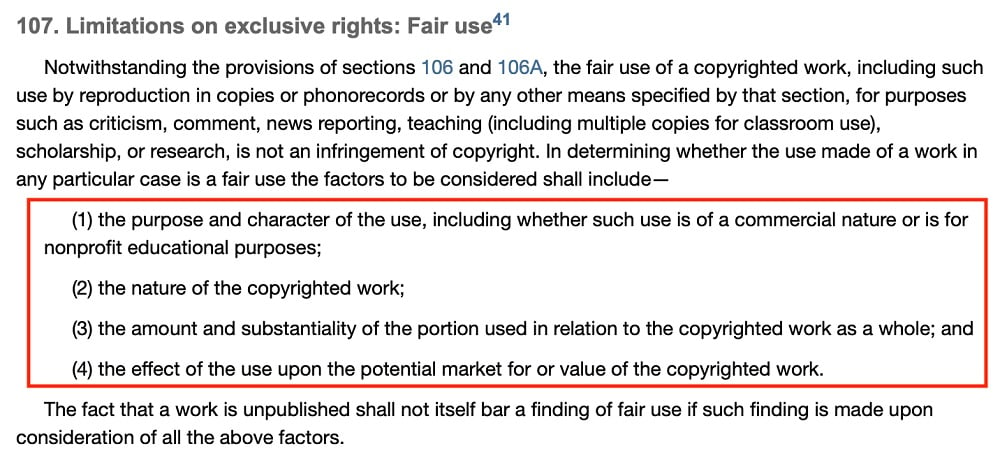
Let's briefly consider these four points.
1. Purpose and Character of Use
It's often fair to use copyrighted work if you don't intend to profit from it and you're using it transformatively i.e. you're adding something new or you're using it for a different purpose than it was originally intended for.
For example, if a school uses a copyrighted diagram solely for teaching purposes, this could be fair use. However, it might not be fair use if the school using it profits from the class in any way even though it's being used transformatively i.e. for a different reason than first intended.
2. Nature of Copyrighted Work
The "nature" of the work usually means whether it's published or unpublished, and factual or creative.
- The courts may have a negative view on anyone trying to use unpublished creative works e.g. a song without the creator's permission.
- It's more likely to be considered fair use if you're sharing published content, particularly if it's factual-based work rather than purely creative.
3. Amount of Copyrighted Work Used
Fair use generally means using the least amount of the work possible. So, for example, it's generally fairer to use a few lines from a song in your video clip than it is to use the whole song.
This one comes down to proportionality. Don't take more of a copyrighted work than you need for a set purpose.
4. Effect on Market Value of the Copyrighted Work
If your use of the work is likely to deprive the creator of profit in some way, then it's usually considered unfair. For example, if using a song is more likely to increase sales of your product rather than the creator's, this is unfair because it erodes the market value of the original work.
You should always ensure you're using copyrighted material legally before relying on a fair use disclaimer. Seek legal advice if you need help complying with copyright law.
What are Fair Use Disclaimers?

A fair use disclaimer is a notice advising people that your website may contain copyrighted material which you don't have permission to use. It should explain that:
- You don't own the copyrighted work, and
- That you're relying on the fair use doctrine
A fair use disclaimer allows you to clearly explain why you're using the work, how you're using it, and why the law allows you to use the work in this way. If you don't include a disclaimer, it could look like you don't understand copyright law, and others could report you for using the content without permission.
Do you always need a fair use disclaimer, though - even for older works? Let's take a look.
How Long Does Copyright Protection Last in the U.S.?
The short answer is that copyright lasts a long time. As a general rule, copyright expires either:
- 70 years after the creator's death, or
- 95 years from the publication date if the work is produced by a company
The rules are set out in Chapter 3 of Title 17:
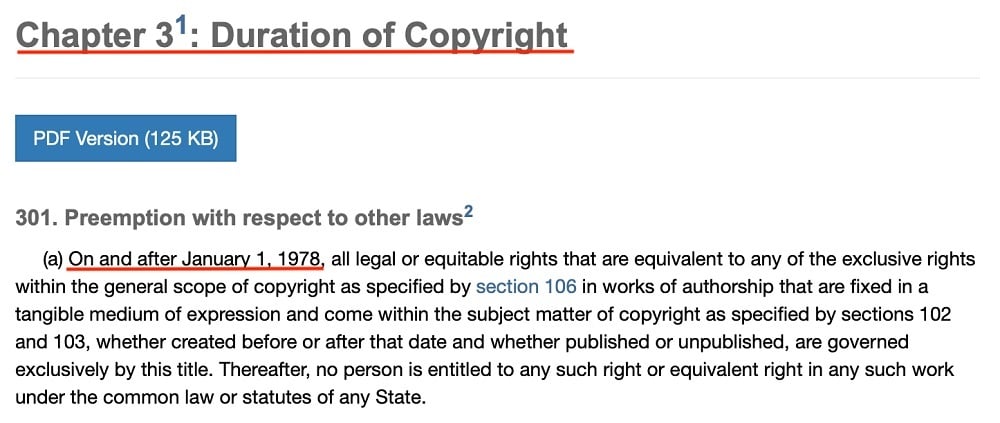
These conditions apply to any work created from January 1, 1978 onwards. But even if it's older work, it may still be copyrighted in some capacity, so to be safe, just assume that work is copyrighted and include a fair use disclaimer when required.
Benefits of Having a Fair Use Disclaimer

Although a fair use disclaimer can't protect you from every potential lawsuit, there are three major benefits to having one.
1. Encourages Fair Information Sharing
Fair use disclaimers allow some content, such as blog posts and essays, to reach a wider audience than they might if they were not shared in some way. This can actually benefit the copyright owner indirectly as it could increase their exposure but it can also help people learn and grow.
2. Boosts Your Reputation for Following Copyright Law
Using a fair use disclaimer means you understand copyright law and how it affects your business. It shows you you are a responsible business owner who cares about complying with your legal responsibilities. This can boost your reputation over time.
3. Minimizes the Risk of Lawsuits
Even if you understand copyright law, other people may not. A fair use disclaimer tells others visiting your website why it's legal for you to use content in a certain way, so they're less likely to raise a dispute with you.
Who Needs a Fair Use Disclaimer?

You need a fair use disclaimer if you're using creative works without an owner's permission and you believe you are using the work in a fair way.
Here are some examples of what might constitute fair use:
- Uploading a photo and turning it into a meme
- Using a sound clip in a documentary film
- Posting parts of an article to offer critical commentary on your personal blog
To be clear, just because you claim you're using the content in a fair way doesn't mean it actually qualifies as fair use. These are just examples of when the doctrine might apply. Seek legal advice if you're unsure.
Drafting a Fair Use Disclaimer

There are five things you should aim to include in any fair use disclaimer. Let's consider what's required and how to draft a disclaimer by referencing some helpful examples.
Declaration of Use
First, confirm that you're using copyrighted materials. This highlights your awareness of copyright law and how it affects your activities.
Here's an example from Hit Songs Deconstructed. The notice begins by explaining that the website may contain copyrighted works, the use for which has not been authorized by the copyright owner.
This is all you need to communicate. You're just explaining that you may be using works without express permission:
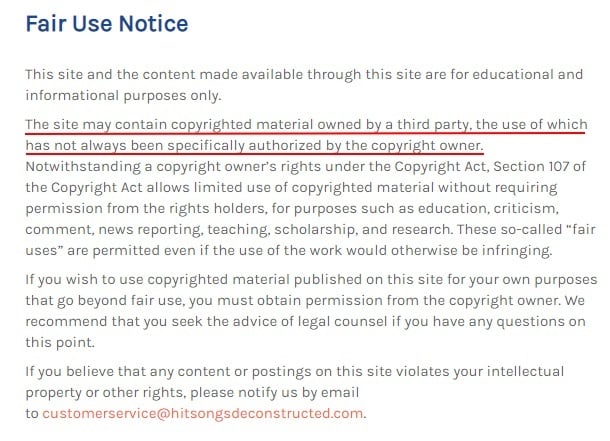
Here's an example from the Oregon Center for Public Policy, which also includes a clear declaration of use:
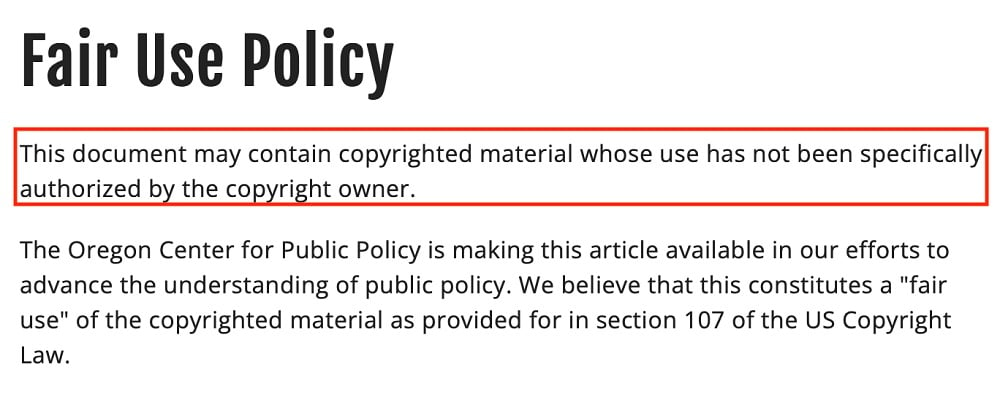
Explain the Purposes for the Use
Once you've declared that you're using copyrighted work, you should explain why you're using it. A common reason is for educational purposes, however it's not the only reason protected by the fair use doctrine.
Accessible Games, for example, begins its notice by explaining the website is educational, and so this is why it's using copyrighted material under the fair use doctrine:

And in the above example from the Oregon Center for Public Policy, note how the disclaimer states that the content is made available to "advance the understanding of public policy." The takeaway, then, is to make sure your reasons for displaying or using the copyrighted material are clear, legitimate, and easy for readers to understand.
An Explanation of Fair Use
Not everyone reading your disclaimer will know about fair use, so briefly explain what the doctrine is and how it applies to your activities.
Multiple Chronic Conditions briefly sets out how fair use works before providing a more comprehensive definition:
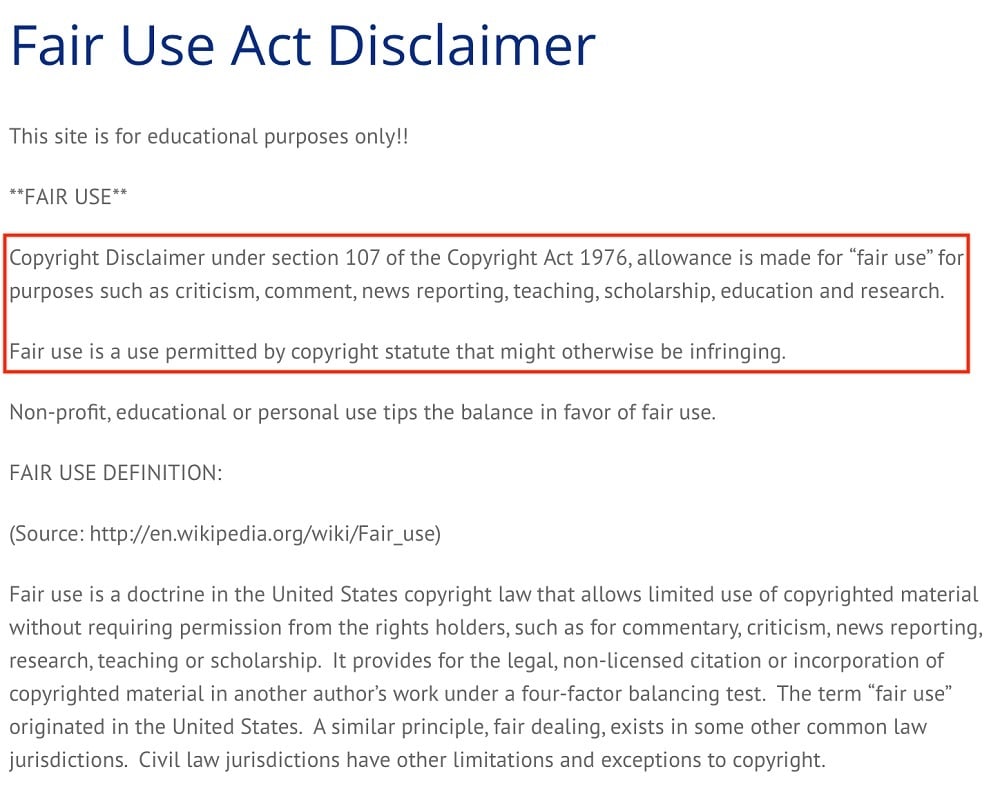
To be clear, you don't need to include a lengthy paragraph like this (although you can, of course, if you believe it will benefit your audience). A brief description of the fair use doctrine, in simple words, is enough for most copyright disclaimers.
Accessible Games has a subsection in its Fair Use Act Disclaimer that's titled "Fair Use Definition." This is a great way to direct readers to the part of your disclaimer that may help them understand more about what fair use is:

Cite U.S. Copyright Law
You should refer to the relevant copyright law, which in this case is Section 107 of Title 17 of the United States Code, or the "U.S. Copyright Law" as this is the law you're relying on to justify using the content without permission.
There's no need to give a detailed breakdown of the law or the applicable clauses. It's enough to cite the law and explain that it gives you a legal basis for using copyrighted content under certain circumstances.
Here's an example from the Digital Languages Symposium at the University of Texas. The clause is very short but it sets out which law applies:
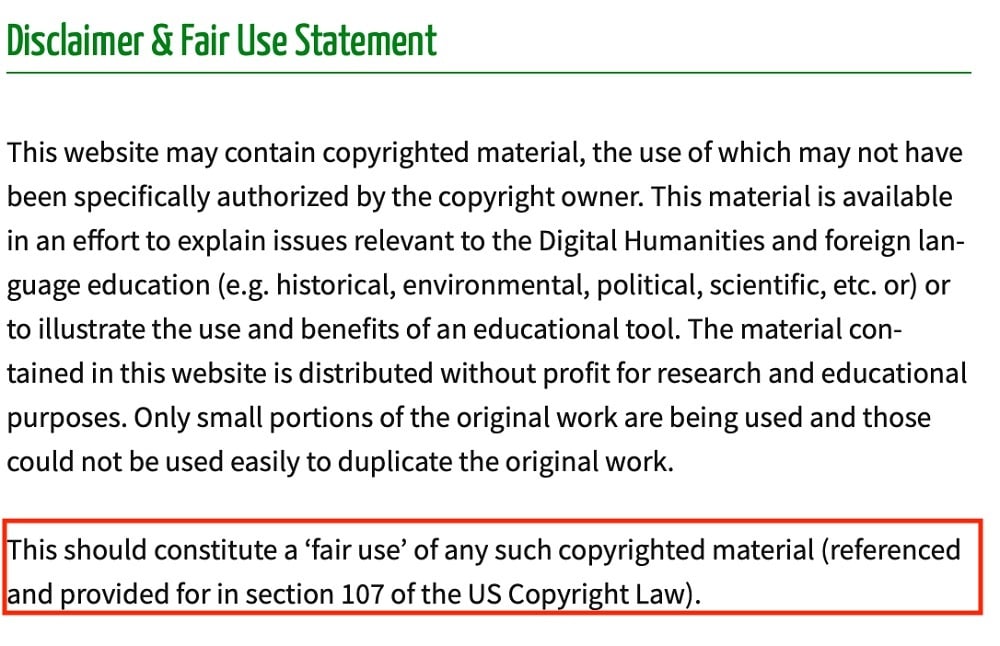
And here's an example from Salesforce Hunt where it clearly cites the relevant law:

However you choose to frame this clause, just ensure that you make mention of the relevant copyright law. This allows readers to check the legal provisions themselves if they wish to.
Third Party Use
While it's not essential, you might advise people that they can't use the original copyrighted work unless they have permission or it's under the fair use doctrine.
Here's an example from Multiple Chronic Conditions. The end of the disclaimer clearly states that you should always get permission before using copyrighted work unless the fair use doctrine applies. What's more, it advises people to seek legal advice before using copyrighted work if they have any doubts:

While you're not responsible for how others choose to use copyrighted content, it's worth adding a sentence of two like this to show you take copyright law seriously.
Displaying a Fair Use Disclaimer

There are two main places to display your copyright notice: In the website footer, and alongside the copyrighted content.
Website Footer
The website footer is an ideal location to host links to all key notices such as your Cookies Policy, Privacy Policy, and Terms and Conditions agreement.
DeviantArt, for example, links to its Copyright Policy, which contains a note on fair use, in its website footer:

You don't need a separate fair use disclaimer link. If the notice is included in your copyright or other policy linked to the footer, this is sufficient.
With the Copyrighted Content
Try to add a fair use disclaimer along with any content that it's relevant to, if possible. For example, If you create media such as YouTube videos which include copyrighted content e.g. movie clips and songs, include a disclaimer in the description.
The Cosmic Wonder uses a short disclaimer to invite creators to contact the company if they're unhappy with their content being used in a certain way:
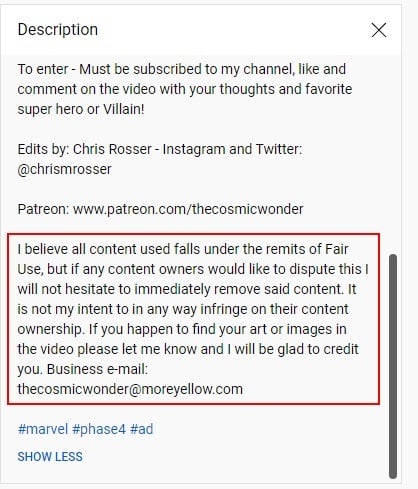
While the notice could be more comprehensive, it does cover the fair use doctrine and put viewers on alert.
Conclusion
"Fair use" lets people use copyrighted works without permission if they use the work for a certain purpose.
Under the Copyright Act of 1976, fair use is determined by four factors:
- How you're using the work e.g. if it's for commercial or non-commercial reasons
- The nature of the actual copyrighted work
- How much of the copyrighted work you use
- Whether your use decreases the market value of the original piece
To publish, share, or use creative works under the U.S. fair use doctrine, you must first determine your usage is, in fact, fair. Then, you need a fair use disclaimer setting out:
- What the fair use doctrine is
- How you're using the work
- Why you're using the work
You should also remind people they can't use the work without permission unless it's for fair use purposes.
Once you have your disclaimer, display it somewhere prominent like your website footer beside your other legal notices, or alongside the copyrighted work.
For information on other types of disclaimers, check out our article on Disclaimer Examples.
